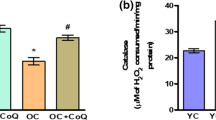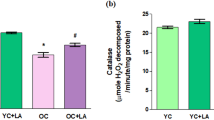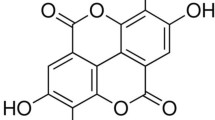Abstract
Objective: Levocarnitine is important in β-oxidation of fatty acids. We evaluated the role of levocarnitine in the skeletal muscle mitochondrial antioxidant system of aged rats.
Methods: Male albino Wistar rats were used in this study. The animals were divided into two groups: young rats (group I) and aged rats (group II). These rats were further subdivided into three groups: one control group (groups Ia and IIa) and two experimental groups (groups Ib, IIb and Ic, IIc) for supplementation with levocarnitine for 14 and 21 days, respectively. After the experimental period, the animals were killed by cervical decapitation; blood and skeletal muscle were isolated for further analysis.
Results: Levels of antioxidant enzymes such as superoxide dismutase, catalase and glutathione peroxidase, and non-enzymatic antioxidants such as reduced glutathione, ascorbic acid (vitamin C) and tocopherol (vitamin E) were found to be decreased in the blood and skeletal muscle mitochondria of aged rats. Supplementation with levocarnitine in aged rats improved the antioxidant status in a dose-dependent manner.
Conclusions: These findings demonstrated that levocarnitine enhances the activity of the mitochondrial antioxidant system and decreases the incidence of free radical-induced lipid peroxidation in aged rats.


Similar content being viewed by others
References
Harman D. Ageing: a theory based on free radical and radiation chemistry. J Gerontol 1956; 11: 298–300
Sohal RS. Role of oxidative stress and protein oxidation in the aging process. Free Radic Biol Med 2002; 33 (1): 37–44
Cadenas E, Davies KJA. Mitochondrial free radical generation, oxidative stress and ageing. Free Radic Biol Med 2000; 26: 222–30
Nicholls DG. Mitochondrial function and dysfunction in the cell: its relevance to aging and aging-related disease. Int J Biochem Cell Biol 2002; 34 (11): 1372–81
Sastre J, Pallardo FV, Vina J. Mitochondrial oxidative stress plays a key role in aging and apoptosis. IUBMB Life 2000; 49 (5): 427–35
Mecocci P, MacGarvey U, Kaufman AE, et al. Oxidative damage to mitochondrial DNA shows marked age dependent increases in human brain. Ann Neurol 1993; 34: 609–16
Wei YH, Lee HC. Oxidative stress, mitochondrial DNA mutation, and impairment of antioxidant enzymes in aging. Exp Biol Med (Maywood) 2002; 227 (9): 671–82
Rani PJ, Panneerselvam C. Effect of L-Carnitine on brain lipid peroxidation and antioxidant enzymes in old rats. J Gerontol A Sci Med Sci 2002; 57 (4): B143–7
Halliwell B, Gutteridge JMC, Cross C. Free radicals and human disease: where are we now? J Lab Clin Med 1992; 119: 598–620
Yasui F, Matsugo S, Ishibashi M, et al. Effect of chronic acetyl-L-carnitine treatment on brain lipid hydroperoxide level and passive avoidance learning in senescence-accelerated mice. Neurosci Lett 2002; 334 (3): 177–80
Sayed-Ahmed MM, Salman TM, Gaballah HE, et al. Propinoyl: L-carnitine as a protector against adriamycin induced cardiomyopathy. Pharmacol Res 2001; 43: 513–20
Bieber LL, Choi YR. Isolation and identification of aliphatatic short chain acylcarnitines from beef heart: possible role for carnitine in branched chain amino acid metabolism. Pro Natl Acad Sci U S A 1997; 74: 2795–8
Nakajima T, Horiuchi M, Yamanaka H, et al. The effect of carnitine on ketogenesis in perfused livers from juvenile visceral steatosis mice with systemic carnitine deficiency. Pediatr Res 1997; 42: 108–13
Chen W, Huang YC, Shultz TD, et al. Urinary, plasma and erythrocyte carnitine concentrations during transition to a lactoovovegetarian diet with vitaminB-6 depletion and repletion in young, adult women. Am J Clin Nutr 1998; 67: 221–30
Ernster L, Nordenbrand K. Skeletal muscle mitochondria. Methods Enzymol 1967; 10: 86–94
Slater EC, Bonner WD. Effect of fluoride on succinate oxidase system. Biochem J 1952; 52: 569–76
Lowry OH, Rosenbrough NJ, Farr AL, et al. Protein measurement with the Folin-phenol reagent. J Biol Chem 1951; 193: 351–8
Okawa H, Oshihi N, Yagi K. Assay for lipid peroxides in animal tissues by thiobarbituric acid reaction. Anal Biochem 1979; 95: 351–8
Marklund S, Marklund G. Involvement of the superoxide anion in the autoxidation of pyrogallol and a convenient assay of superoxide dismutase. Eur J Biochem 1974; 47: 469–74
Sinha AK. Colorimetric assay of catalase. Anal Biochem 1972; 47: 389–94
Rotruk JT, Pope AL, Ganther HE, et al. Selenium: biochemical role as a component of glutathione peroxidase. Science 1973; 179: 588–90
Moron MS, Depierre JW, Mannervik B. Levels of glutathione reductase and gulutathione S-transferase activities in rat lung and liver. Biochem Biophys Acta 1979; 582: 67–70
Omaye ST, Turnbull JD, Sauberlich HE. Selected methods for the determination of ascorbic acid in animal cells, tissues and fluids. Methods Enzymol 1979; 62: 1–11
Desai ID. Vitamin E analysis method for animal tissues. Methods Enzymol 1984; 105: 138–43
Lenaz G. Role of mitochondria in oxidative stress and ageing. Biochim Biophys Acta 1998; 1366 (1–2): 53–67
Mecocci P, Beal MF, Cecchetti R, et al. Mitochondrial membrane fluidity and oxidative damage to mitochondrial DNA in aged and AD human brain. Mol Chem Neuropathol 1997; 31 (1): 53–64
Chen JJ, Yu BP. Alteration in the mitochondrial membrane fluidity by lipid peroxidation products. Free Radic Biol Med 1994; 17: 411–8
Esterbauer H, Schaur RJ, Zoller S. Chemistry and biochemistry of 4-hydroxynonenal, malondialdehyde and related aldehydes. Free Radic Biol Med 1991; 11: 81–128
Sverko V, Balog T, Sobocanec S, et al. Age associated alteration of lipid peroxidation and superoxide dismutase activity in CBA and AKR mice. Exp Gerontol 2002; 197: 119–24
Shol R, Dubey A. Mitochondrial oxidative damage, hydrogen peroxide release and ageing. Free Radic Biol Med 1994; 16: 621–6
Hagen TM, Moreau R, Suh JH, et al. Mitochondrial decay in the aging rat heart: evidence for improvement by dietary supplementation with acetyl-L-carnitine and/or lipoic acid. Ann N Y Acad Sci 2002; 959: 491–507
Rani PJA, Panneerselvam C. Carnitine as a free radical scavenger in ageing. Exp Gerontol 2001; 30: 1713–26
Harris ED. Regulation of antioxidant enzymes. FASEB J 1992; 6: 2675–83
Russel RL, Siedlak SL, Raina AK, et al. Increased neuronal glucose-6-phosphate dehydrogenase and sulfhydryl levels indicate reductive compensation to oxidative stress in Alzheimer’s disease. Arch Biochem Biophys 1999; 370: 236–9
Alvarez E, Santa Maria C, Machodo A. Respiratory burst reaction changes with age in rat peritoneal macrophages. Biochim Biophys Acta 1993; 1179: 247–52
Ketterer B. Protective role of glutathione and glutathione transferase in mutagenesis and carcinogenesis. Mutat Res 1998; 202: 343–61
Fernandez-Checa JC, Yi J, Garcia Ruzi C, et al. Plasma membrane and mitochondrial transport of hepatic reduced glutathione. Semin Liver Dis 1996; 16: 147–58
Singh RJ. Glutathione: a marker and antioxidant for ageing. J Lab Clin Med 2002; 140: 380–1
Kiziltunc A, Cogalgil S, Cerrahoglu L. Carnitine and antioxidants levels in patients with rheumatoid arthritis. Scand J Rheumatol 1998; 27: 441–5
Hagen TM, Ingersoll RT, Wehr CM, et al. Acetyl-L-carnitine fed to old rats partially restores mitochondrial function and ambulatory activity. Proc Natl Acad Sci U S A 1998; 95: 9562–6
Rebouche CJ. Carnitine function and requirement during the life cycle. FASEB J 1992; 6: 3379–86
Bertoni-Freddari C, Fattoretti P, Caselli U, et al. Vitamin E deficiency as a model of precocious brain ageing: assessment by x- ray microanalysis and morphometry. Scanning Microsc 1995; 9: 289–301
Acknowledgements
The authors gratefully acknowledge Dr D. Kumaran, Reader, Department of Education, University of Madras, Chepauk for his very kind assistance in statistical analysis, and thank the University Grant Commission, New Delhi, India for financial assistance in carrying out this work.
Author information
Authors and Affiliations
Rights and permissions
About this article
Cite this article
Kumaran, S., Deepak, B., Naveen, B. et al. Effects of Levocarnitine on Mitochondrial Antioxidant Systems and Oxidative Stress in Aged Rats. Drugs R&D 4, 141–147 (2003). https://doi.org/10.2165/00126839-200304030-00001
Published:
Issue Date:
DOI: https://doi.org/10.2165/00126839-200304030-00001




